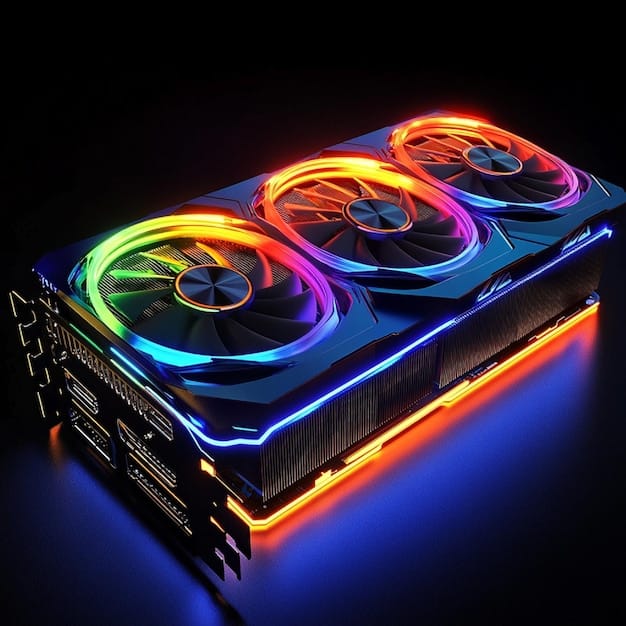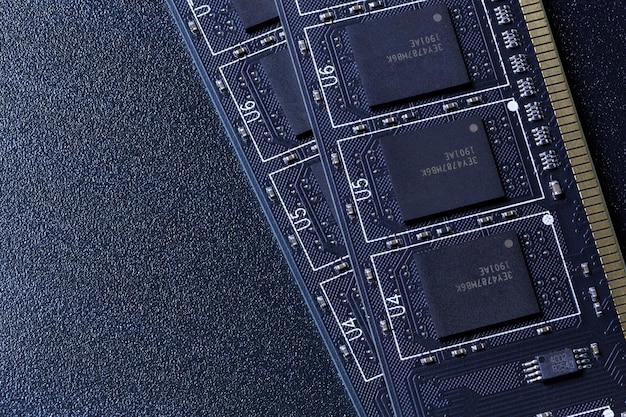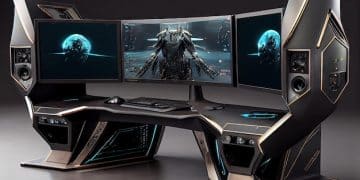Optimize Your PC for 1440p Gaming in 2025: 60+ FPS Guide

Achieving over 60 FPS in 1440p gaming by 2025 requires a strategic upgrade path focusing on GPU power, CPU optimization, and efficient memory, ensuring a balanced system that maximizes performance without unnecessary bottlenecks, delivering an immersive visual experience.
Diving into the world of high-resolution gaming is exhilarating, and by 2025, reaching that sweet spot of 60+ frames per second at 1440p resolution is more accessible than ever. This guide will show you how to Optimize Your PC for 1440p Gaming in 2025: A Data-Driven Guide to Achieving 60+ FPS, cutting through the noise to focus on what truly matters for peak performance.
Understanding 1440p Gaming Demands
Before we delve into specific components and optimizations, it’s crucial to understand what 1440p resolution (2560×1440 pixels) entails for your PC’s hardware. This resolution offers a significant visual upgrade over 1080p, but it also demands considerably more processing power from your graphics card and, to a lesser extent, your CPU. Unlike 1080p, where a mid-range GPU might suffice for 60 FPS, 1440p gaming often requires a more robust graphics solution to maintain smooth frame rates, especially in graphically intensive titles.
The pixel count at 1440p is approximately 78% higher than 1080p. This translates directly into more work for your GPU, as it has to render significantly more pixels per frame. To consistently achieve 60+ FPS, your system needs to push out a substantial amount of data, making every component choice critical. Think of it as painting a much larger canvas with the same amount of time – you need more efficient tools or more painters.
The Difference Between 1080p and 1440p
While 1080p (Full HD) remains the most common gaming resolution, 1440p (Quad HD) offers a sharper image and more screen real estate, which can be particularly advantageous in competitive games where visual clarity is key. This increased detail can reveal subtle nuances in game environments, enhancing immersion and providing a competitive edge. However, the step up in visual fidelity comes at a hardware cost.
- Increased Pixel Count: 1440p has 3.6 million pixels compared to 2.1 million for 1080p.
- Sharper Images: Games appear much crisper, with less aliasing and more detailed textures.
- Higher Demands: Requires more powerful GPUs and often a faster CPU to avoid bottlenecks.
Frame rate targets are equally important. While 30 FPS might be considered playable by some, 60+ FPS is the widely accepted standard for a smooth and responsive gaming experience, especially in fast-paced genres. For many, a high refresh rate monitor (120Hz, 144Hz, or even 240Hz) is also part of the 1440p dream, which further elevates hardware requirements beyond just hitting 60 FPS. Understanding these foundational demands sets the stage for a targeted optimization approach.
Ultimately, optimizing for 1440p 60+ FPS is about balancing visual quality with performance. It’s not just about raw power; it’s about smart power allocation. This section lays the groundwork for understanding why certain hardware choices and software optimizations are crucial for this specific gaming experience.
GPU: The Cornerstone of 1440p Performance
The graphics processing unit (GPU) is unequivocally the most critical component when aiming for 60+ FPS at 1440p resolution. In 2025, the landscape of GPUs is likely to be dominated by further advancements in architecture, ray tracing capabilities, and power efficiency. Your GPU choice will dictate the settings you can run, the frame rates you’ll achieve, and the overall visual fidelity of your gaming experience. Investing in a powerful GPU is not just recommended; it’s essential for a satisfying 1440p setup.
As games become more visually demanding, especially with widespread adoption of technologies like path tracing and advanced global illumination, the GPU will be under immense pressure. Future titles will likely push the boundaries of graphical realism, meaning a GPU that seems powerful today might just be “adequate” for 1440p in two years.
Recommended GPU Tiers for 2025
When considering a GPU for 1440p gaming in 2025, you’ll need to look at components capable of handling intense workloads. Based on current trends and projected technological advancements, here’s a breakdown of recommended tiers:
- High-End (Enthusiast): GPUs like the NVIDIA RTX 5000 series or AMD RX 8000 series equivalents will offer uncompromised 1440p performance, often exceeding 100+ FPS even with ray tracing enabled. These are for gamers who want the best visual quality and highest frame rates without compromises.
- Mid-to-High Range (Sweet Spot): Cards in the NVIDIA RTX 4070/4080 (or their 2025 successors) and AMD RX 7800 XT/7900 XT (or successors) lineups will likely be the sweet spot for 1440p 60+ FPS. These GPUs provide excellent performance per dollar, balancing high frame rates with reasonable cost. Expect 60-90 FPS consistently, with some adjustment to settings for ultra-demanding titles.
- Budget-Conscious (Entry-Level 1440p): For those on a tighter budget, GPUs equivalent to today’s RTX 4060 Ti or RX 7700 XT might offer playable 1440p experiences, often requiring some graphical settings to be lowered. You’ll likely hit 60+ FPS in many games but not all, and definitely not at maximum settings in future AAA titles.
Beyond raw processing power, consider factors like VRAM capacity. For 1440p, 12GB of VRAM should be considered a minimum, with 16GB or more being ideal for future-proofing against increasingly demanding textures and effects. Look for GPUs with efficient cooling solutions to prevent thermal throttling, which can significantly reduce performance during extended gaming sessions. Always check actual game benchmarks for specific titles you plan to play.

The choice between NVIDIA and AMD may also depend on specific ecosystem features, such as NVIDIA’s DLSS and AMD’s FSR, both of which are crucial for boosting frame rates at higher resolutions with minimal visual loss. We’ll explore these upscaling technologies in more detail later.
CPU and Memory: Ensuring a Balanced System
While the GPU shoulders the heaviest load in 1440p gaming, the central processing unit (CPU) and system memory (RAM) play crucial supporting roles. A powerful GPU can be bottlenecked by an inadequate CPU, leading to lower-than-expected frame rates, especially in CPU-intensive games or scenarios with many AI characters or complex physics. Similarly, insufficient or slow RAM can cause micro-stutters and reduce overall system responsiveness, even if your GPU is top-tier.
In 2025, multithreading capabilities will be even more critical for CPUs, as game engines continue to leverage multiple cores more effectively. Processors with a high core count and strong single-core performance will offer the best balance for gaming and other background tasks.
CPU Recommendations for 1440p
For 1440p gaming, you typically don’t need the absolute bleeding-edge CPU, but certainly not a low-end one. The emphasis shifts slightly from raw single-core speed (which is paramount at 1080p) to a good balance of core count and clock speed. Here’s what to look for:
- Intel Core i5/i7 (and successors): Intel’s current 13th/14th gen i5 and i7 processors (or their 2025 equivalents) offer excellent gaming performance. Look for models with at least 6-8 performance cores.
- AMD Ryzen 5/7 (and successors): AMD’s Ryzen 5 and 7 series are also strong contenders, offering competitive multi-core performance. Processors like the Ryzen 5 7600X or Ryzen 7 7700X (or their 2025 counterparts) provide a great gaming experience.
- Avoid Bottlenecks: Aim for a CPU that won’t limit your chosen GPU. Generally, an upper mid-range CPU paired with a high-end GPU is a good combination to avoid CPU bottlenecks at 1440p.
When selecting a CPU, consider its boost clock speeds and cache size, as these contribute significantly to gaming performance. Also, pay attention to the platform (Intel’s LGA sockets or AMD’s AM5) as this will dictate your motherboard choice and upgrade path.
RAM Requirements: Speed and Capacity
Memory has evolved considerably, and DDR5 RAM is becoming a standard. For 1440p gaming in 2025, the following guidelines apply:
- Capacity: 16GB of RAM should be considered the bare minimum, but 32GB is highly recommended for future-proofing. Many modern games are starting to consume more than 16GB, especially with background applications running.
- Speed: For DDR5, aim for speeds of 6000MHz to 6400MHz with low CL (CAS Latency) timings (e.g., CL30 or CL32). Faster RAM can improve minimum frame rates and overall system responsiveness, particularly on AMD platforms.
- Dual Channel: Always install RAM in dual-channel configuration (e.g., two 16GB sticks instead of one 32GB stick) to maximize memory bandwidth.
The combination of a capable CPU and ample, fast RAM ensures that your GPU has a consistent supply of data to process, preventing micro-stutters and maintaining those buttery-smooth 60+ FPS gameplays. Don’t overlook these components in your quest for optimal 1440p performance.
Furthermore, ensuring your motherboard supports the latest CPU and RAM standards is crucial. A good motherboard provides stable power delivery, efficient cooling for critical components, and adequate expansion slots for future upgrades. It acts as the central nervous system connecting all your high-performance parts.
Storage and Power Supply: The Unsung Heroes
While often overshadowed by GPUs and CPUs, your storage solution and power supply unit (PSU) are critical components that can significantly impact your 1440p gaming experience. A slow storage drive can lead to lengthy load times and texture pop-in, while an inadequate or unreliable PSU can cause system instability, crashes, and potential damage to your expensive components. Neglecting these “unsung heroes” can undermine the performance of even the most powerful gaming rig.
As game file sizes continue to grow exponentially, fast storage becomes increasingly important, not just for loading screens but also for seamless texture streaming in open-world titles. Similarly, as hardware becomes more powerful, its power draw also increases, making a robust and efficient PSU a necessity.
Ultrafast Storage: NVMe SSDs
For gaming in 2025, especially at 1440p, a solid-state drive (SSD) is non-negotiable. More specifically, an NVMe SSD is the standard. Unlike traditional hard disk drives (HDDs) or even older SATA SSDs, NVMe drives connect directly via the PCIe interface, offering vastly superior read and write speeds. This translates to:
- Faster Game Loading: Dramatically reduced loading screens, getting you into the action quicker.
- Reduced Texture Pop-in: Games with large open worlds can stream assets much faster, leading to a more seamless visual experience.
- Improved System Responsiveness: Quicker boot times, application launches, and overall snappier system performance.
Aim for a Gen4 NVMe SSD as a minimum for your primary game drive. Gen5 NVMe drives are emerging and offer even higher speeds, which might become more relevant for future game engines designed to leverage ultra-fast storage directly (e.g., Microsoft’s DirectStorage API). A capacity of at least 1TB is advisable for your main game library, with 2TB or more being ideal to accommodate the ever-growing size of AAA titles.

Power Supply Unit (PSU): Never Skimp Here
The PSU is often the component gamers save money on, but it’s a critical mistake. A cheap or underpowered PSU can jeopardize your entire system. For a 1440p gaming PC in 2025, consider the following:
- Wattage: Calculate your system’s total power draw (GPU and CPU are the biggest consumers) and add a buffer of 20-30%. For modern high-end GPUs, a 750W to 850W minimum is often recommended, with 1000W or more for enthusiast setups. Use online PSU calculators as a guide.
- Efficiency Rating: Look for a PSU with an 80 PLUS Gold or Platinum rating. This indicates higher efficiency, meaning less wasted heat and lower electricity bills. More importantly, it often correlates with higher quality components and better reliability.
- Modularity: Fully modular PSUs are preferred as they allow you to connect only the cables you need, improving cable management and airflow within your case.
- Brand Reputation: Stick to reputable brands like Seasonic, Corsair, EVGA, be quiet!, or Cooler Master. These brands are known for their quality, reliability, and excellent warranty support.
A stable and reliable power delivery from your PSU ensures that your components receive consistent power, preventing crashes or performance drops during peak loads. It also protects your precious hardware from power fluctuations, making it an investment in the longevity and stability of your gaming rig.
Cooling Solutions: Keeping Your System Optimal
Generating high frame rates at 1440p resolution inevitably means your PC components will be working hard and, consequently, generating more heat. Effective cooling is paramount; without it, your CPU and GPU will “throttle” their performance to prevent overheating, leading to a significant drop in frame rates and overall system stability. Investing in a robust cooling solution is not an optional luxury but a necessity for maintaining optimal performance over long gaming sessions.
Modern CPUs and GPUs are designed with thermal limits, and exceeding these limits triggers protective measures. A well-designed cooling system ensures these components can boost to their maximum potential for sustained periods, delivering the consistent 60+ FPS you desire.
CPU Cooling: Air vs. Liquid
For CPUs, you generally have two primary cooling options:
- Air Coolers: High-performance air coolers are often competitive with liquid coolers in terms of raw cooling performance, especially for mid-range to high-end CPUs. They are typically more affordable, easier to install, and require less maintenance. Good options include large tower coolers from brands like Noctua or be quiet!.
- All-in-One (AIO) Liquid Coolers: AIO liquid coolers offer excellent cooling, particularly for higher-end, overclockable CPUs. They can also offer a cleaner aesthetic inside your case. Look for 240mm or 360mm radiator sizes from reputable brands like Arctic, Corsair, or NZXT. While generally more expensive and sometimes require more careful installation, they provide superior thermal management for enthusiast-level processors.
The choice often comes down to budget, aesthetics, and the specific CPU you’re running. Ensure your chosen cooler fits your PC case and doesn’t interfere with your RAM modules.
GPU Cooling and Case Airflow
While GPUs come with their own integrated cooling solutions (fans, heatsinks), effective case airflow is critical for their performance. A well-ventilated case ensures that fresh, cool air is constantly supplied to your GPU, and hot air is efficiently exhausted. This prevents heat buildup inside the case, known as “heat soak,” which can negatively impact all components.
- Case Fans: Install a sufficient number of case fans (typically 2-3 intake fans at the front/bottom and 1-2 exhaust fans at the rear/top) to create positive or neutral airflow. This pushes hot air out and draws cool air in.
- Case Design: Choose a case with good airflow features, such as mesh front panels and ample ventilation holes. Avoid cases with solid front panels that restrict air intake.
- Cable Management: Tidy cable management is not just for aesthetics; it also prevents cables from obstructing airflow, allowing cool air to reach components unobstructed.
Regular cleaning of dust filters and fan blades is also crucial for maintaining optimal cooling performance over time. Dust acts as an insulator, reducing the efficiency of your cooling system. By paying attention to both component-specific cooling and overall case airflow, you can ensure your system remains cool and stable, allowing your CPU and GPU to deliver their best performance consistently for an uncompromised 1440p gaming experience.
Software Optimizations and Settings
Hardware provides the raw power, but software optimizations and smart in-game settings are what truly unlock your PC’s full potential for 1440p gaming. Even with a high-end system, neglecting these aspects can lead to underperformance, stutters, and a less enjoyable experience. The goal is to maximize frames per second while maintaining visual quality that complements the 1440p resolution.
The synergy between hardware and software is critical; a perfectly tuned system can make a big difference, often turning a “good” gaming experience into a “great” one without needing further hardware upgrades. It’s about efficiency and making every component work smarter, not just harder.
Driver Updates and Operating System Tweaks
Keeping your system software up-to-date is arguably the easiest yet most impactful optimization:
- Graphics Drivers: Always install the latest WHQL (Windows Hardware Quality Labs) certified drivers for your NVIDIA or AMD GPU. These often include game-specific optimizations, performance bug fixes, and new features that can significantly boost frame rates. Set driver updates to automatic or check regularly.
- Operating System: Ensure Windows (or your preferred OS) is fully updated. Microsoft frequently releases performance patches and security updates that can affect gaming.
- Background Processes: Minimize unnecessary background applications. Close web browsers with many tabs, streaming services, and other heavy programs while gaming. Use Task Manager to identify resource-hogging processes.
- Game Mode: Enable Windows Game Mode. This feature prioritizes system resources for games, improving performance.
Regular maintenance, such as disk cleanup and defragmentation (for HDDs, not SSDs), can also contribute to overall system health, though their direct impact on FPS is usually minor compared to driver updates.
In-Game Settings and Upscaling Technologies
This is where you finely tune your visual experience and performance balance:
- Resolution Scaling: For games that support it, running at 100% resolution scale is ideal for true 1440p. If your FPS drops in specific titles, consider lowering it slightly (e.g., to 90% or 85%) before reducing other settings.
- Upscaling Technologies (DLSS/FSR): NVIDIA’s DLSS (Deep Learning Super Sampling) and AMD’s FSR (FidelityFX Super Resolution) are game-changers for 1440p gaming. These technologies render the game at a lower resolution and then use AI (DLSS) or spatial upscaling (FSR) to reconstruct the image to 1440p, often with minimal perceivable quality loss. Enable these if available for significant FPS boosts, typically using “Quality” or “Balanced” modes.
- Texture Quality: This setting is highly dependent on your GPU’s VRAM. At 1440p, you generally want to maintain high or ultra texture quality if you have 12GB+ VRAM. Lowering it can free up VRAM and improve performance if you’re hitting limits.
- Shadows and Volumetric Effects: These are often very demanding. Reducing shadow quality, resolution, or volumetric effects can yield substantial FPS gains with a less noticeable visual downgrade compared to other settings.
- Anti-Aliasing: At 1440p, aliasing is less pronounced than at 1080p due to higher pixel density. You might be able to use less aggressive (or even disable) anti-aliasing techniques like MSAA or TAA, saving performance. FXAA or a lighter TAA implementation is usually sufficient.
- Ray Tracing: While visually stunning, ray tracing is incredibly demanding. If frame rates are an issue, consider lowering ray tracing settings or disabling it. DLSS/FSR are almost essential when enabling ray tracing at 1440p.
Experiment with settings. Start with high presets and gradually reduce the most demanding options one by one until you achieve your desired 60+ FPS target. Monitor your GPU and CPU usage while making these adjustments to identify bottlenecks. Software optimizations, coupled with intelligent in-game settings, ensure your powerful hardware is utilized to its fullest, delivering an exceptional 1440p gaming experience.
Future-Proofing Your 1440p Rig for Beyond 2025
Building a PC is an investment, and while we’re optimizing for 1440p 60+ FPS in 2025, it’s wise to consider how to future-proof your rig for the years beyond. Technology evolves rapidly, and what’s cutting-edge today can be mid-range tomorrow. Future-proofing doesn’t mean buying the most expensive component in every category, but rather making strategic choices that allow for easier and more cost-effective upgrades down the line, ensuring your system remains capable and competitive.
The goal is to avoid major platform overhauls too frequently, like needing a new motherboard for a new CPU, or finding your GPU’s VRAM insufficient for upcoming titles. Smart decisions now can save significant money and hassle in the future.
Strategic Component Choices for Longevity
When selecting your components, think about their upgrade paths and longevity:
- Motherboard: Opt for a motherboard on a relatively new and stable platform (e.g., AMD’s AM5 or Intel’s LGA 1700/1851 if a new one is introduced for 15th/16th gen). These platforms usually support several generations of CPUs, allowing you to upgrade your processor without changing the motherboard. Ensure it has PCIe Gen5 support for future GPUs and NVMe SSDs.
- CPU: While you don’t need the absolute top-tier CPU for 2025, buying one or two notches below the enthusiast peak provides a powerful chip that will remain relevant for several years. This leaves room for a future CPU upgrade on the same motherboard.
- RAM: 32GB of fast DDR5 RAM (6000MHz+) is highly recommended. While 16GB might suffice for some games in 2025, 32GB provides a comfortable buffer for increasingly demanding titles and multitasking, future-proofing your memory needs.
- PSU: Invest in a high-quality, high-wattage (850W-1000W) 80 PLUS Gold/Platinum PSU from a reputable brand. GPUs are becoming more power-hungry, and a robust PSU will comfortably power future, more demanding graphics cards.
- Case: Choose a spacious case with excellent airflow and support for large GPUs and liquid coolers. A good case can last for many builds and accommodates future hardware sizes.
Prioritizing parts that offer flexibility and a longer lifespan, even if slightly more expensive upfront, ultimately saves money and effort in the long run. The GPU is the most frequently upgraded component, but the other core parts can endure through several GPU generations with careful planning.
Embracing Emerging Technologies
Beyond raw hardware, keeping an eye on and embracing new technologies can also extend the life of your rig:
- Upscaling Technologies: DLSS and FSR will continue to evolve, offering improved image quality and performance. Ensure your GPU supports these or their successors.
- DirectStorage: As more games utilize APIs like DirectStorage, ultra-fast NVMe SSDs (especially Gen5) will become increasingly important for loading times and texture streaming.
- New API Features: Stay updated on advancements in graphics APIs like DirectX and Vulkan, as new features can often be leveraged through driver updates to improve performance or visual fidelity.
Future-proofing isn’t about halting technological progress, but rather smart adaptation. By making informed choices today about core components and staying aware of emerging software and hardware trends, you can ensure your 1440p gaming PC remains a powerhouse well beyond 2025, providing smooth, high-fidelity experiences for years to come.
Maintaining Peak Performance: Long-Term Strategies
Building an optimized PC for 1440p gaming is just the first step. To consistently achieve 60+ FPS in 2025 and beyond, ongoing maintenance and strategic management are crucial. Like any high-performance machine, a gaming PC requires regular care to prevent degradation in performance, avoid unexpected issues, and ensure its longevity. Neglecting these long-term strategies can lead to frustrating frame drops, system instability, and a diminished gaming experience.
A well-maintained system not only performs better but also lasts longer, protecting your significant hardware investment. It’s about being proactive rather than reactive to problems.
Regular Software Updates and Driver Management
As previously mentioned, keeping software current is vital, but it also requires a strategy:
- Graphics Drivers: While automatic updates are convenient, it’s often wise to wait a few days after a major driver release to check user feedback. Occasionally, new drivers can introduce bugs. If you encounter issues, rolling back to a previous stable driver version is an option.
- BIOS/UEFI Updates:Periodically check for motherboard BIOS/UEFI updates. These can bring performance improvements, stability fixes, and support for newer hardware. However, BIOS updates carry a small risk, so only perform them when necessary and follow manufacturer instructions carefully.
- Operating System and Game Patches: Ensure Windows updates are installed, and your games are always patched to their latest versions. Developers frequently release performance optimizations and bug fixes.
Consistent, cautious updating ensures you benefit from the latest improvements without falling victim to potential software regressions.
Hardware Maintenance and System Monitoring
Physical care of your PC is just as important as software management:
- Dust Management: Regularly clean your PC to remove dust buildup from fans, heatsinks, and vents. Dust acts as an insulator, hindering cooling performance and causing components to run hotter, leading to thermal throttling. Use compressed air, but hold fan blades steady to prevent over-spinning them.
- Cable Management Review: Over time, cables can shift. Periodically check that cables are tidy and not obstructing airflow.
- Thermal Paste: After several years (typically 3-5), the thermal paste on your CPU (and sometimes GPU) might degrade. Replacing it can significantly improve thermal transfer and reduce temperatures. This is a more advanced task.
- System Monitoring: Use tools like MSI Afterburner (for GPU monitoring), HWMonitor, or CPU-Z to keep an eye on temperatures, clock speeds, and usage percentages while gaming. This helps identify any thermal throttling or unexpected bottlenecks. If temperatures are consistently high, it’s a sign that your cooling or airflow needs attention.
Early detection of potential issues through monitoring can prevent minor problems from escalating into major system failures or performance inhibitors. Maintaining optimal temperatures is paramount to maximizing the lifespan and consistent performance of your high-powered components.
By integrating these long-term maintenance strategies into your routine, you can ensure your 1440p gaming PC remains a reliable and high-performing machine, delivering exhilarating 60+ FPS experiences for years to come, without the constant need for new hardware. It truly is about treating your PC as an investment that requires ongoing care.
| Key Optimization Areas | Brief Description |
|---|---|
| 🚀 GPU Power | Invest in high-end to upper mid-range GPUs (e.g., RTX 5000/4070 series successors) with ample VRAM (12GB+). |
| 🧠 CPU & RAM Balance | Pair a capable mid-to-high-end CPU (Intel i5/i7, AMD Ryzen 5/7) with 32GB of fast DDR5 RAM (6000MHz+). |
| 💾 Fast Storage & PSU | Utilize NVMe Gen4/Gen5 SSDs (1-2TB+) and a reliable, efficient (850W+ Gold/Platinum) PSU. |
| ⚙️ Software & Cooling | Maintain updated drivers, optimize in-game settings (DLSS/FSR), and ensure robust CPU/GPU cooling with good case airflow. |
Frequently Asked Questions About 1440p Gaming Optimization
While 16GB of RAM might still be sufficient for some games in 2025, 32GB is increasingly becoming the recommended standard for 1440p gaming. Many newer AAA titles, especially open-world games, are starting to consume more than 16GB, particularly when combined with background applications. Upgrading to 32GB ensures smoother performance, prevents stutters, and future-proofs your system.
For 1440p gaming, the GPU is generally the bottleneck and therefore more important than the CPU. However, a balanced system is crucial. A weak CPU can bottleneck even a powerful GPU, leading to lower frame rates than expected, particularly in CPU-intensive games or scenarios. Aim for a mid-to-high-end CPU (e.g., Intel i5/i7 or AMD Ryzen 5/7) to ensure it doesn’t hold back your GPU’s performance.
Yes, absolutely! DLSS (NVIDIA) and FSR (AMD) are highly recommended for 1440p gaming. These upscaling technologies can provide significant boosts to frame rates with minimal perceived loss in image quality. They render the game at a lower resolution and intelligently reconstruct the image to 1440p. Use them on “Quality” or “Balanced” settings for the best balance between performance and visual fidelity, especially with ray tracing enabled.
For a 1440p gaming PC in 2025, with modern high-end GPUs, a power supply unit (PSU) of 750W to 850W is generally the minimum recommended, while 1000W or more is ideal for enthusiast builds or future-proofing. Always opt for an 80 PLUS Gold or Platinum rated PSU from a reputable brand to ensure efficiency, reliability, and stability for your expensive components.
Maintaining optimal temperatures is crucial. Ensure you have a good CPU cooler (either a high-end air cooler or a 240mm/360mm AIO liquid cooler). Your PC case should have excellent airflow with sufficient intake and exhaust fans. Regularly clean dust from your components and filters, and manage cables neatly to avoid obstructing airflow. Monitoring temperatures with software can help detect issues early.
Conclusion
Achieving a smooth, immersive 1440p gaming experience at 60+ FPS in 2025 is a tangible goal with strategic component selection and diligent optimization. By prioritizing a powerful GPU, balancing it with a capable CPU and ample fast RAM, and not overlooking the critical roles of storage, PSU, and robust cooling, you establish a solid foundation. Couple this hardware prowess with smart software management, including driver updates and leveraging upscaling technologies like DLSS or FSR, and your PC will not only deliver exceptional performance today but also remain future-proofed for the evolving demands of gaming. A well-maintained and thoughtfully configured system is key to unlocking the full potential of your high-resolution gaming endeavors.





